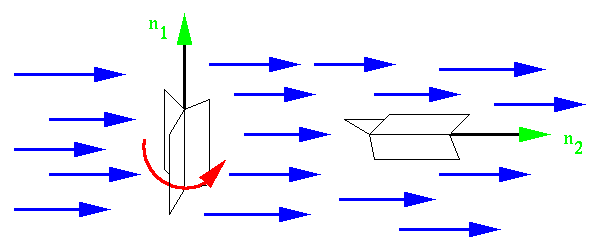Rather than treat the curl as some random thing, let's derive a more
physical interpretation of the curl. We start by examining the concept of
circulation density. The circulation density of a vector field
![]() at a point P is exactly what it sounds like. We compute the
circulation of the vector field around some curve C which is normal to a
given vector,
at a point P is exactly what it sounds like. We compute the
circulation of the vector field around some curve C which is normal to a
given vector, ![]() . We then divide by the area enclosed by the curve
and shrink the whole thing down onto the point P.
. We then divide by the area enclosed by the curve
and shrink the whole thing down onto the point P.
The reason we need to specify the curve as normal to some unit vector
![]() is obvious from the example below. Circulation measures the
swirl, so if we place a paddle wheel in a vector field, the paddles will
rotate at a speed depending on the circulation. The higher the
circulation, the faster the spin. On the left, we've placed the paddles so
that they get the maximum circulation in a plane normal to the axis,
is obvious from the example below. Circulation measures the
swirl, so if we place a paddle wheel in a vector field, the paddles will
rotate at a speed depending on the circulation. The higher the
circulation, the faster the spin. On the left, we've placed the paddles so
that they get the maximum circulation in a plane normal to the axis,
![]() . On the right, the paddle doesn't spin at all because the
circulation is zero in the plane normal to
. On the right, the paddle doesn't spin at all because the
circulation is zero in the plane normal to ![]() .
.

Thus, if C is a curve around P enclosing a region of area R and having
a unit normal vector ![]() , then
, then
 |
(7) |
A few technical details are needed here. Check the text for a reference on these.
With a little thought, we realize that the circulation density is a vector
quantity. This lets us write the circulation density around a unit vector
![]() as (letting
as (letting ![]() )
)
| (8) |
With a great deal of algebra, one can show that the curl of
![]() is a vector such that
is a vector such that